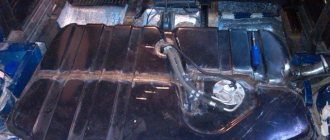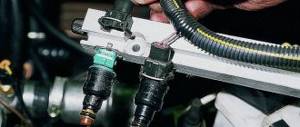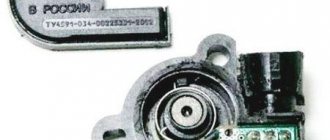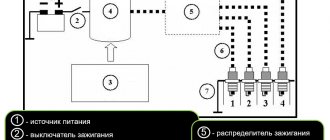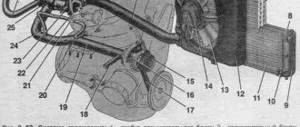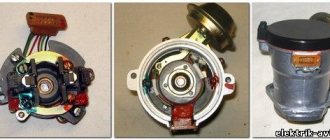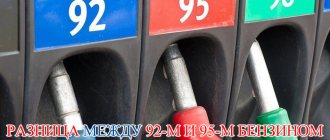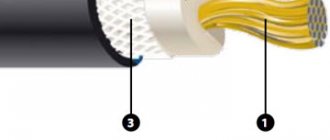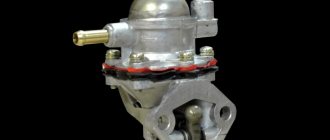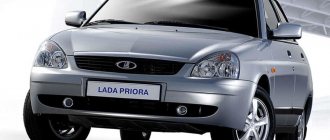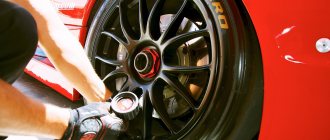A fuel rail or rail is a section of a hollow tube with ends closed on both sides and outlets for connecting smaller diameter pipes through which fuel is supplied to the injectors.
The fuel rail is one of the elements “inherited” to a gasoline engine from a diesel engine. Another well-known element that “migrated” from there to direct injection systems is the fuel injection pump.
In some cases, the injectors are attached directly to the ramp. The fuel rail is used in almost all multipoint injection systems, although in some designs the fuel is discharged to the injectors from the regulator body.
Design and location of the fuel rail
Typically, the ramp is installed on the engine intake manifold. In addition to the outlet pipes, the ramp has a hole with a shut-off fitting for connecting a pressure gauge, which controls the fuel pressure. To prevent contamination, it is closed with a threaded plug. Most often, the ramp is made of seamless steel pipe that can withstand high pressure. In the case of a diesel engine equipped with a common rail system, this pressure can be very high.
The main purpose of the fuel rail is to supply fuel and distribute it to the injectors.
When removing fuel injectors from the rail, extreme care must be taken. One wrong move can lead to the need to replace the injector.
When the injection pump operates, fuel enters the supply line located in the block head. Once in the ramp, the fuel moves towards the farthest cylinder. Some injection system designs provide for heating the fuel with the heat generated by the engine during operation. Warming up improves atomization.
Types of engine fuel supply systems
Depending on the design of the car, its year of manufacture and the type of combustible material on which it runs, fuel systems have their own differences.
By fuel type:
- gasoline;
- diesel
This is interesting: Which is better Mitsbishi ASX or Nissan Qashqai
The design of these fuel systems is radically different and read about their features below.
Gasoline engines, in turn, are divided into:
- carburetor;
- injectors.
In modern cars, carburetor fuel supplies are almost never found. Most have injectors. But cars produced 10 - 15 years ago were equipped with carburetors, so we will also look at the operating principle of such systems.
Fuel system of carburetor engines
By design, the carburetor consists of a body, a float chamber, valves, jets, and a mixture of the forming chamber. In the carburetor system, there is one fuel pump installed - low pressure. It is installed in the engine compartment, near the carburetor. The pump pumps fuel into the float chamber. This chamber got its name from the float that regulates its filling. If there is more fuel in the chamber than needed, the float raises the needle valve. The needle valve closes the fuel supply to the chamber. If there is a lack of fuel in the chamber, the whole process occurs in reverse.
From the float chamber, fuel is supplied through a nozzle, which is a tube with a small hole, into the mixing chamber. In this chamber, gasoline is mixed with air, which in turn comes from the air intake.
The fuel supply is regulated by the throttle valve, which is connected by a cable to the gas pedal in the car. From the carburetor, the mixture is supplied to the engine using reverse thrust from the cylinder-piston group. In other words, the piston sucks in the fuel mixture.
There are three types of fuel mixture:
- Enriched . This mixture contains an increased amount of fuel and a reduced volume of air. This in turn leads to excessive fuel consumption. This mixture is used when starting a car engine. This is regulated using the so-called “suction”. After warming up the engine, the mixture must be returned to normal and the “suction” removed.
- Normal . The mixture contains the right amount of fuel and air. This is, in other words, the golden mean.
- Depleted . In this mixture there is more air than necessary, and less fuel. This entails a reduction in consumption and power. The car will have difficulty climbing hills, especially when loaded. The speed will become significantly slower.
The quality of the mixture on the carburetor is adjusted with a bolt. In general, it is worth saying that the carburetor has an idle speed and mixture quality screw. It is the mixture quality screw that regulates its composition.
If you don’t understand how to regulate, then it’s better to entrust this matter to a professional. This work is very precise and requires skills.
This is interesting: Punishment of a driver for exceeding the speed limit on the road
One of the most common problems with carburetor types of systems is self-adjustment. There are situations when the problem is not in the settings at all, but, for example, in a broken needle valve. Due to the overflow of the float chamber, the flow rate increases, and car enthusiasts begin to turn the screws of the educator mixture. It doesn't lead to anything.
Features of the fuel injection system
The difference between the injection type engine and the carburetor type is as follows. The fuel pump creates high pressure and supplies fuel to the fuel rail, and from it through the injectors to the engine. The control unit regulates the fuel supply, its quantity and quality.
It is possible to make any adjustments only through a special computer. In addition, the control unit will not give a signal to supply fuel if at least one sensor in the car fails. The panel will display an error with the name. By the name of the error, you can decipher which sensor has failed.
Diesel engine fuel system diagram
A diesel engine has a different fuel system than a gasoline engine. Ignition of the fuel mixture occurs due to air compression and heating. In such systems, spark plugs are not used to detonate the mixture. Diesel engines use spark plugs, but incandescent ones. They serve to heat the fuel system during startup. They are not needed during work.
The diesel system has two fuel pumps. One of them is high pressure, and the other is low. The low pressure pump pumps fuel from the tank. The high pressure pump creates the required pressure in the system during injection. The role of a distributor is performed by nozzles; they dose the quantity of the mixture and determine its quality. There is a special stand to check injector wear.
A feature of the diesel engine is the lack of regulation of mixture quality. This is especially true in winter at low temperatures. Also in winter, diesel starts to freeze. To prevent this from happening, additives are used.
Fuel rail operation issues
If for some reason the fuel rail needs to be removed, you must proceed with extreme caution, as there is a high risk of damaging the injector nozzles and connector contacts. Under no circumstances should dirt be allowed to get into open channels and pipelines, since after assembly it will inevitably get into the injectors and the matter will end, at a minimum, with washing them. During maintenance, the holes must be closed with plugs. Before removal, the fuel rail can be cleaned using a can of injector cleaner. Under no circumstances should the ramp be placed in flushing solvent without disconnecting the injectors. The fact is that all the holes in the fuel rail are equipped with rubber sealing rings, which will fail if placed in an aggressive environment. By the way, in any repair manual you can find a recommendation to change the rubber gaskets in any case, even if they are not externally damaged.
The design of the engine fuel system and its purpose
A car's fuel system is the system that supplies fuel to the engine. The main function of the fuel system is to supply fuel to the engine. In addition, the fuel system is responsible for storing and purifying fuel. Let's consider the design of the engine fuel system. The elements of a car’s fuel system are a tank, fuel drives, a pump, mixture formation devices, injectors, and filters.
- Tank.
It stores gasoline or diesel. To draw fuel, the tank is equipped with a pump. - Pump.
A device that directly supplies fuel to the carburetor or injectors (depending on what type of engine is installed on the car - carburetor or with fuel injection). - Fuel lines.
Hoses, tubes with which the high-pressure fuel pump is connected to the injectors. Directly involved in transporting fuel to the mixture formation device. Fuel lines play two functions: they supply fuel to the tank, and, on the contrary, remove excess fuel. In this regard, fuel lines are supply and drain. - Mixture formation devices (injector, carburetor or single injection)
. In these devices, fuel is combined with air, resulting in an emulsion (in this form the fuel enters the engine cylinders). - Fuel level sensors.
Serve to determine the fuel level in the tank. They work in tandem with the fuel mixture level indicator on the dashboard. Sensors can be contact or non-contact. When working with traditional fuels (gasoline, diesel), contact sensors are sufficient. Non-contact sensors are recommended for aggressive environments (if biodiesel, methanol, ethanol is used as fuel). - Injection devices.
Electronics for coordination and control of the operation of injectors, sensors, misfire valves. - Filters.
Additional filters for coarse and fine cleaning. In most cases (with the exception of engines with direct fuel injection), filters are built into the pressure reducing valve (responsible for regulating the operating pressure in the system). - Fuel heaters.
Relevant for diesel engines. The need to install heaters in this case is determined by the properties of the diesel fuel itself. As the temperature drops, its viscosity level increases, which adversely affects the functioning of the device.
Types of fuel systems
Vehicles come in petrol and diesel. Moreover, each of them has many variations. It all depends on how the fuel injection occurs.
Gasoline fuel injection systems:
- Carburetor. Fuel is drawn into the air stream that passes through the carburetor due to the vacuum created by the narrowing of the air channel. A mechanical or electric fuel pump takes fuel from the tank and delivers it to the carburetor.
- Over-throttle injection. The fuel assembly is screwed to the intake manifold. The fuel is supplied via an electronic module through the fuel injector into the air flow directed to all engine cylinders.
- Distribution (multipoint or manifold) injection. Some of the most advanced. It is based on fuel injection into each cylinder using a separate nozzle. Can be controlled either mechanically or electronically.
- Discrete injection. The fuel system operates on a pulse cycle. The work takes into account the mass air flow readings obtained by the sensors.
- Direct injection. Injection supply. Injection is carried out directly into the internal combustion chamber, and not into the intake manifold. This solution allows you to optimize the level of fuel efficiency, but the design of a fuel system focused on direct injection is very demanding on fuel quality.
But diesel vehicles are usually classified as follows:
- Systems with fuel injection pump (in-line and distribution type);
- Systems with pump injectors;
Battery systems.
The high-pressure fuel pump in such systems supplies fuel to the common fuel distribution rail. Our next articles will be devoted to the specifics of gasoline and diesel system devices. In particular, specific examples of solutions from Bosch Corporation will be considered. Modular training through electronic interactive programs on the ELECTUDE platform will help you understand in detail the operation of car systems. Including, a simulator is built into the platform. Therefore, the operation of systems is considered not on the “fingers”, but in practice. Simulation training allows you not only to understand the work, but also to prepare for specific service operations.
